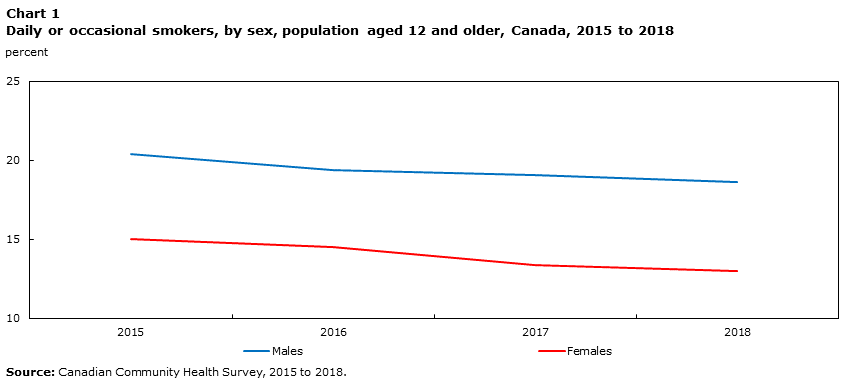Health Fact Sheets
Smoking, 2018
In 2018, 15.8% of Canadians aged 12 and older (roughly 4.9 million people) smoked cigarettes either daily or occasionally.Note 1 Among both sexes, the number of current smokers has declined between 2015 and 2018 (from 20.4% to 18.6% for males and from 15.0% to 13.0% for females, Chart 1).Note 2

Data table for Chart 1
| Males | Females | |
|---|---|---|
| percent | ||
| 2015 | 20.4 | 15.0 |
| 2016 | 19.4 | 14.5 |
| 2017 | 19.1 | 13.4 |
| 2018 | 18.6 | 13.0 |
| Source: Canadian Community Health Survey, 2015 to 2018. | ||
Among the sexes, the proportion in 2018 who smoked daily or occasionally was higher among males (18.6%) than females (13.0%). Across all age groups, smoking was least common among youth aged 12 to 17 (3.2%, Chart 2).Note 3

Data table for Chart 2
| Age group | Percent | Confidence Interval | |
|---|---|---|---|
| lower 95% limit | upper 95% limit | ||
| Males | |||
| Total (12 years and older) | 18.6 | 17.7 | 19.4 |
| 12 to 17 years | 3.3Note E: Use with caution | 2.1 | 4.5 |
| 18 to 19 years | 17.4 | 12.4 | 22.3 |
| 20 to 34 years | 23.9 | 21.9 | 26.0 |
| 35 to 49 years | 22.1 | 20.2 | 24.0 |
| 50 to 64 years | 20.3 | 18.6 | 22.0 |
| 65 years and older | 11.1 | 9.8 | 12.4 |
| Females | |||
| Total (12 years and older) | 13.0 | 12.4 | 13.7 |
| 12 to 17 years | 3.0 | 2.2 | 3.9 |
| 18 to 19 years | 16.9Note E: Use with caution | 11.0 | 22.7 |
| 20 to 34 years | 14.8 | 13.3 | 16.3 |
| 35 to 49 years | 14.3 | 13.0 | 15.6 |
| 50 to 64 years | 16.5 | 15.0 | 18.0 |
| 65 years and older | 8.5 | 7.5 | 9.4 |
|
E use with caution Source: Canadian Community Health Survey, 2018. |
|||
Of the 4.9 million current smokers, the majority (3.4 million) smoked cigarettes daily. The majority of current non-smokers were lifetime abstainers, having never smoked a whole cigarette. Just over one in five Canadians (21.3%) in 2018 were current non-smokers who used to be daily smokers (Chart 3).

Data table for Chart 3
| Percent | |
|---|---|
| Current daily smoker | 10.9 |
| Current occasional smoker | 4.9 |
| Former daily smoker (non-smoker now) |
21.3 |
| Former occasional smoker (non-smoker now) | 2.9 |
| Experimental smoker | 12.7 |
| Lifetime abstainer | 47.3 |
|
Note: Experimental smokers are current non-smokers who have had at least one whole cigarette in their lifetime. Source: Canadian Community Health Survey, 2018. |
|
People typically begin smoking during their teenage yearsNote 4, so the percentage who have not started smoking by age 20 is an indicator of future smoking rates. In 2018, 62.6% of those aged 20 to 24 had never smoked a whole cigarette. Within this age group, the proportion for never smoking was higher for females than for males (70.2% vs 55.9%). Overall, the number of 20 to 24 year olds who have never smoked a whole cigarette has increased from 2015 (57.9%).
The proportion of residents who smoked daily or occasionally was lower than the national average (15.8%) in:
- British Columbia (12.0%)
The proportion of residents who smoked daily or occasionally was higher than the national average in:
- Nova Scotia (18.0%)
- Quebec (17.5%)
- Saskatchewan (20.1%)
The proportion of residents who smoked daily or occasionally was about the same as the national average in all other provinces.
Start of text boxAbout Smoking
Smoking is a risk factor for lung cancer, heart disease, stroke, chronic respiratory disease, and other conditions.Note 5 According to the World Health Organization, smoking is an important and preventable cause of death.Note 6
The Canadian Community Health Survey (CCHS) categorizes respondents by smoking status based on their self-reported smoking habits:
- Lifetime abstainer - Has never smoked a whole cigarette.
- Experimental smoker - Has smoked at least 1 whole cigarette, but less than 100 in their lifetime.
- Former occasional smoker (non-smoker now) - Currently doesn’t smoke, but has smoked at least 100 cigarettes in their lifetime. These respondents have never smoked daily.
- Former daily smoker (non-smoker now) - Currently doesn’t smoke, but has smoked at least 100 cigarettes in their lifetime. These respondents have previously smoked daily.
- Current occasional smoker - Smokes cigarettes occasionally.
- Current daily smoker - Smokes cigarettes every day.
The CCHS smoking rate covers cigarettes that are bought ready-made as well as cigarettes that are self-made, but does not include electronic cigarettes.
References
Shields, M. 2007. Smoking bans: Influence on smoking prevalence. Health Reports. Statistics Canada Catalogue no. 82-003. Vol. 18, no. 3. (accessed February 25, 2019).
Shields, M. 2005. The journey to quitting smoking. Health Reports. Statistics Canada Catalogue no. 82-003. Vol. 16, no. 3. (accessed February 25, 2019).
Shields, M. 2005. Youth smoking. Health Reports. Statistics Canada Catalogue no. 82-003. Vol.16, no. 3. (accessed February 25, 2019).
World Health Organization. 2008. WHO Report on the Global Tobacco Epidemic, 2008.The MPOWER Package. Geneva. (accessed February 25, 2019).
Jiajian, C., and W.J. Millar. 1998. Age of smoking initiation: Implications for quitting. Health Reports. Statistics Canada Catalogue no. 82-003. Vol. 9, no. 4. (accessed February 25, 2019).
Data
Additional data from the Canadian Community Health Survey are available from table 13-10-0096-01.
- Date modified:
